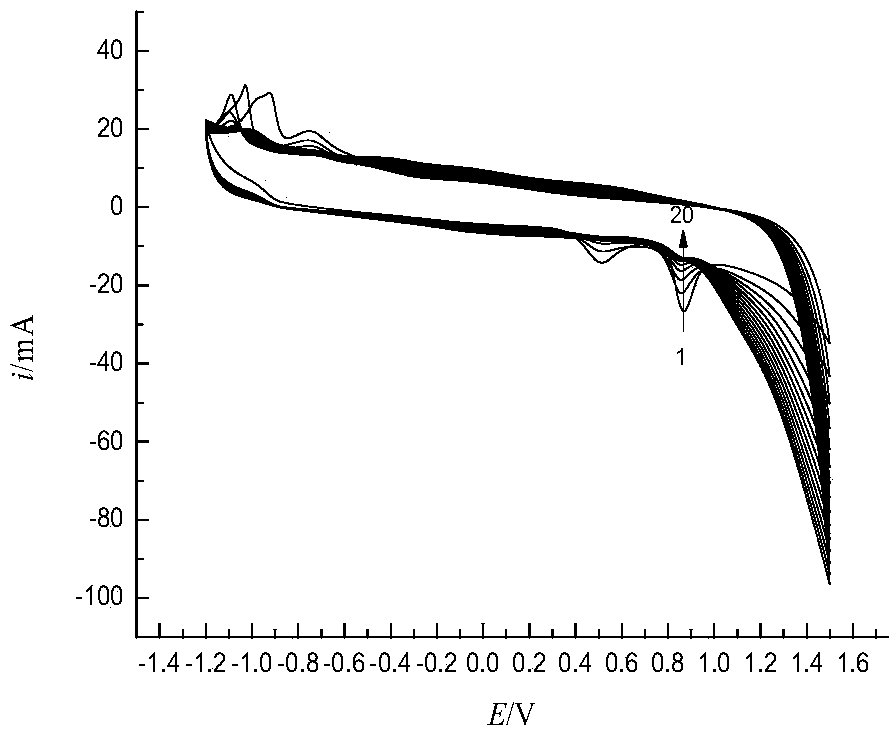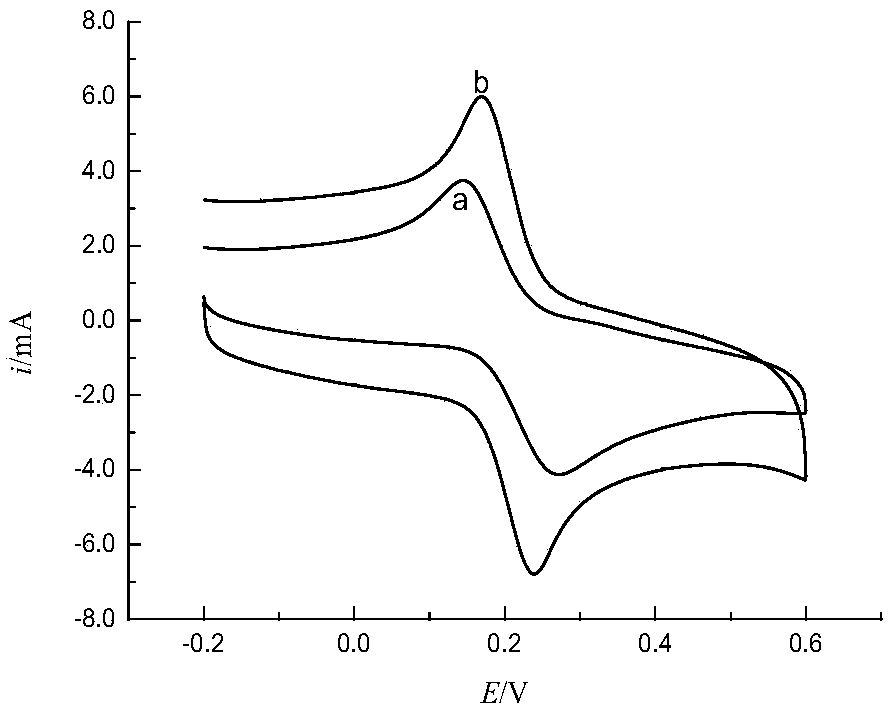Method for determining hydroquinone in wastewater by poly eosin Y modified glassy carbon electrode
A glassy carbon electrode, hydroquinone technology, applied in the field of electrochemical analysis, achieves the effect of wide linear range, low detection limit, and simple electrode preparation
- Summary
- Abstract
- Description
- Claims
- Application Information
AI Technical Summary
Problems solved by technology
Method used
Image
Examples
Embodiment 1
[0033] a. Pretreatment of glassy carbon electrode
[0034] Polishing powder (Al 2 O 3 Powder) is ground to a mirror surface, measured in the characterization solution by cyclic voltammetry, and then rinsed with water twice. When the redox peak potential difference is less than 0.07V and the two adjacent characterization curves basically overlap, the electrode is placed in 0.1mol / L of H 2 SO 4 In the voltage range of 0.4-0.6V, scanning 20 times at a scanning speed of 100mV / s to obtain a processed glassy carbon electrode.
[0035] b. Polyeosin Y modified glassy carbon electrode
[0036] Use acetate buffer solution with pH=7.0 to prepare a concentration of 1.0×10 -3 For the mol / L Eosin Y solution, pass nitrogen for 20 minutes before each use to remove the oxygen in the solution. In the voltage range of -1.2~1.5V, the eosin Y solution was scanned with different cycles of cyclic voltammetry at a scanning speed of 100mV / s.
[0037] As the number of scanning cycles increases, the current o...
Embodiment 2
[0039] In Example 2, a, the pretreatment of the glassy carbon electrode and b, the polyeosin Y modified glassy carbon electrode are the same as in Example 1. On the basis of Example 1, the pEY / GCE modified electrode is used as the working electrode, saturated calomel The electrode is the reference electrode, and the platinum wire electrode is the counter electrode. Within the potential range of -0.2~0.6V, in the acetate buffer solution of pH=5.0, scanning different concentrations of hydroquinone at a sweep rate of 100mV / s The cyclic voltammogram of the solution was recorded at the same time.
[0040] figure 2 1.0×10 -4 Cyclic voltammogram of mol / L hydroquinone on polyeosin Y modification. Curve a is the cyclic voltammetry curve of hydroquinone on a bare glassy carbon electrode. It can be seen from the figure that hydroquinone is on the electrode. There is a pair of good redox peaks, oxidation peak potential (E pa ) And reduction peak potential (E pc ) Are 0.27V and 0.145V resp...
Embodiment 3
[0043] The pretreatment of a, glassy carbon electrode and b, polyeosin Y modified glassy carbon electrode in Example 3 are the same as those in Examples 1 and 2. On the basis of Examples 1 and 2, other variables are fixed and the sweep speed is changed. To analyze the effect of scanning speed on the electrochemical behavior of hydroquinone.
[0044] Such as image 3 It is the cyclic voltammogram of hydroquinone on the modified electrode under different scanning speeds. Within the scanning speed range of 60~240mV / s, the pEY / GCE modified electrode pair is 1.0×10 -4 Cyclic voltammetry scanning of mol / L hydroquinone solution maintains good redox reversibility within this sweep speed range. The redox peak potential has a slight deviation during the entire scanning process ( image 3 ), indicating that there is weak adsorption on the electrode surface, so the sweep speed is selected as 100mV / s. Peak oxidation current (i pa ) And the square root of the sweep speed (v 1 / 2 ) And sweep spe...
PUM
| Property | Measurement | Unit |
|---|---|---|
| recovery rate | aaaaa | aaaaa |
Abstract
Description
Claims
Application Information
 Login to View More
Login to View More - R&D
- Intellectual Property
- Life Sciences
- Materials
- Tech Scout
- Unparalleled Data Quality
- Higher Quality Content
- 60% Fewer Hallucinations
Browse by: Latest US Patents, China's latest patents, Technical Efficacy Thesaurus, Application Domain, Technology Topic, Popular Technical Reports.
© 2025 PatSnap. All rights reserved.Legal|Privacy policy|Modern Slavery Act Transparency Statement|Sitemap|About US| Contact US: help@patsnap.com



